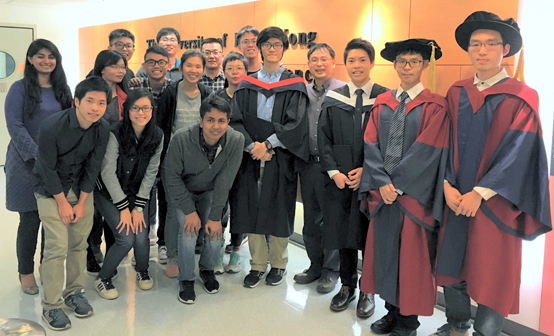Leadership

Professor JIN, Dong-Yan 金冬雁
- BSc (Sun Yat-sen U); DMedSc (Chinese Acad of Precentive Med)
- Clara and Lawrence Fok Professor in Precision Medicine
- Senior Associate Dean, Graduate School
- Associate Director (Grants and Collaborations), School of Biomedical Sciences
- Molecular virology and oncology
Research in our laboratory is focused primarily on the molecular basis of viral diseases and cancer. We use a combination of biochemical and genetic approaches to conduct basic research in molecular virology and oncology with the aim to apply the knowledge gained to medicine. Areas of special current interest include viral oncogenesis and innate antiviral immunity. In connection to these two major areas of research, our interests also extend to other general aspects of molecular cell biology, including transcriptional regulation, post-translational protein modifications, cell signaling and non-coding RNAs.
In our study of human T-cell leukemia virus type I oncoprotein Tax, we identified a cellular protein named MAD1, a key component of the mitotic checkpoint (Jin et al., 1998). We also characterized another centrosomal target of Tax protein that might contribute to the development of aneuploidy in leukemic cells (Ching et al., 2006). Our investigations on Epstein-Barr virus revealed a new mechanism in which a viral microRNA targets a cellular proapoptotic protein to promote the survival of tumour cells (Choy et al., 2008). We also found that the cytoplasmic virus sensor RIG-I needs a double-stranded RNA-binding protein partner called PACT to initiate and sustain innate antiviral response (Kok et al., 2011). Our findings have revealed novel disease mechanisms, in the next stage we will endeavor to translate them into new targets and strategies in the prevention and precision treatment of human diseases.
Our research projects are funded by grants from Hong Kong Research Grants Council (RGC) and Hong Kong Health and Medical Research Fund (HMRF).
- Molecular mechanism of viral oncogenesis
- Molecular mechanism of innate antiviral immunity

- Chaudhary, V., Yuen, K.-S., Chan, J.F.-W., Chan, C.-P., Wang, P.-H., Cai, J.P., Zhang, S., Liang, M., Kok, K.-H., Chan, C.-P., Yuen, K.-Y. and Jin, D.-Y. Selective activation of type II interferon signaling by Zika virus NS5 protein. J Virol. 91: e00163-17, 2017 (http://jvi.asm.org/content/91/14/e00163-17.long)
- Tang, H.-M.V., Gao, W.-W., Chan, C.-P., Cheng, Y., Chaudhary, V., Deng, J.-J., Yuen, K.-S., Wong, C.-M., Ng, I.O.-L., Kok, K.-H., Zhou, J. and Jin, D.-Y. Requirement of CRTC1 coactivator for hepatitis B virus transcription. Nucl. Acids Res. 42: 12455-12468, 2014 (http://nar.oxfordjournals.org/content/42/20/12455.long)
- Kok, K.-H., Lui, P.-Y., Ng, M.-H.J., Siu, K.-L., Au, S.W.N. and Jin, D.-Y. The double-stranded RNA-binding protein PACT functions as a cellular activator of RIG-I to facilitate innate antiviral response. Cell Host Microbe, 9: 299-309, 2011 (http://www.sciencedirect.com/science/article/pii/S1931312811000941)
- Tang, H.-M.V., Siu, K.-L., Wong, C.-M. and Jin, D.-Y. Loss of yeast peroxiredoxin Tsa1p induces genome instability through activation of DNA damage checkpoint and elevation of dNTP levels. PLoS Genet., 5: e1000697,2009 (http://www.plosgenetics.org/article/info%3Adoi%2F10.1371%2Fjournal.pgen.1000697 )
- Choy, E.Y.-W., Siu, K.-L., Kok, K.-H., Lung, R.W.-M., Tsang, C.M., To, K.-F., Kwong, D.L.-W., Tsao, S.W. and Jin, D.-Y. An Epstein-Barr virus-encoded microRNA targets PUMA to promote host cell survival. J. Exp. Med., 205: 2551-2560, 2008 (http://jem.rupress.org/cgi/content/full/205/11/2551) (Recommended by Faculty of 1000)
- Ching, Y.-P., Chan, S.-F., Jeang, K.-T. and Jin, D.-Y. (2006) Retroviral oncoprotein Tax targets the coiled-coil centrosomal protein TAX1BP2 to induce centrosome overduplication. Nat. Cell Biol., 8: 717-724 (http://www.nature.com/ncb/journal/v8/n7/abs/ncb1432.html)
- Chin, K.-T., Zhou, H.-J., Wong, C.-M., Lee, J.M.-F., Chan, C.-P., Qiang, B.-Q., Yuan, J.-G., Ng, I.O.-L. and Jin, D.-Y. (2005) The liver-enriched transcription factor CREB-H is a growth suppressor protein underexpressed in hepatocellular carcinoma. Nucl. Acids Res., 33: 1859-1873 (http://nar.oxfordjournals.org/cgi/content/full/33/6/1859)
- Jin, D.-Y., Spencer, F. and Jeang,K.-T. (1998) Human T-cell leukemia virus type I oncoprotein Tax targets the human mitotic checkpoint protein MAD1. Cell, 93: 81-91 (http://www.cell.com/retrieve/pii/S0092867400811484)
- Jin, D.-Y., Li, Z.-L., Jin, Q., Yuwen, H. and Hou, Y.-D. (1989) Vaccinia virus hemagglutinin: A novel member of the immunoglobulin superfamily. J. Exp. Med., 170: 571-576 (http://www.ncbi.nlm.nih.gov/pmc/articles/PMC2189399/pdf/je1702571.pdf)
- Outstanding Research Student Supervisor Award (2014/15)
- Croucher Senior Research Fellowship (2014)
- Outstanding Researcher Award, HKU (2008)
- NIH-GRIP New Foreign Investigator (2002-2008)
- Leukemia and Lymphoma Society Scholar (2001-2006)
- National Natural Science Award (2001)

